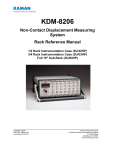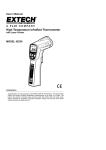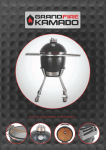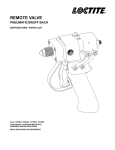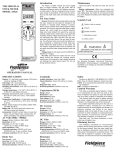Download sC66 - Fieldpiece Instruments
Transcript
Digital CLAMP Meters SC66 SC67 ! WARNINGS ! Clean the exterior with clean dry cloth. Do not use liquid. Battery Replacement: When the multimeter displays “ “ the battery must be replaced. Disconnect and unplug leads, turn meter off, and remove the battery cover. Replace the battery with a NEDA type 1604 9V battery. General: Disconnect the test leads before opening the case. Inspect the test leads for damage to the insulation or exposed metal. Replace if suspect. Never ground yourself when taking electrical measurements. Do not touch exposed metal pipes, outlets, fixtures, etc., which might be at ground potential. Keep your body isolated from ground by using dry clothing, rubber shoes, rubber mats, or any approved insulating material. When disconnecting from a circuit, disconnect the “RED” lead first, then the common lead. Work with others. Use one hand for testing. Turn off power to the circuit under test before cutting, unsoldering, or breaking the circuit. Keep your fingers behind the finger guards on the probes. Do not measure resistance when circuit is powered. Do not apply more than rated voltage between input and ground. All Voltage Tests: All voltage ranges will withstand up to 600VDC or 600VAC. Do not apply more than 600VDC or 600VAC. AC Tests: Disconnect the meter from the circuit before turning any inductor off, including motors, transformers, and solenoids. High voltage transients can damage the meter beyond repair. Do not use during electrical storms. Hi voltage indicator Field OF calibration DISCONNECT AND UNPLUG TEST LEADS before opening case. TEST NCV FUNCTION ON KNOWN LIVE WIRE before using. DO NOT APPLY VOLTAGE greater than 30VAC or 60VDC to the thermocouple or the jacks when the rotary dial is on OF. REMOVE THE THERMOCOUPLE when taking voltage measurements. DISCONNECT THE TEST LEADS when taking temperature measurements. DO NOT APPLY VOLTAGE TO THE JACKS when the rotary dial is on microamps. Even low voltages can cause a current overload and blow the fuse. Replace blown fuse to regain function. Maintenance General description Models SC66 and SC67 have special features for the HVAC/R service technician who wants to carry one instrument. For your safety... Symbols used: Caution, risk of electric shock ! Caution, refer to manual. Ground Double insulation OPERATOR’S MANUAL Non-contact voltage (NCV) With the NCV tab on the tip of the clamp close to an AC voltage, press the NCV button, the NCV LED will light and the beeper will beep. The closer you get to AC voltage, the louder the beep. The NCV function is sensitive enough to detect 24VAC on thermostats. Microamps DC For measuring the flame diode current in a heater control. The clamp meter is protected by a PTC resistor, not a fuse. When an overload occurs on µADC, reset the PTC by disconnecting from the circuit for at least 30 seconds. Capacitance For motor-start and motor-run capacitors. Disconnect the capacitor from power first. Short the terminals to discharge the capacitors. Disconnect any resistors that might be between the terminals of the capacitor. Auto power off To extend the life of your battery, the meter automatically turns off after approximately 60 minutes. In any VAC/VDC range when you touch a voltage greater than 30V, the beeper will beep and the red Hi-V LED will blink. BE CAREFUL! MAX hold for safety Before measuring voltage, press MAX button and keep your eyes on your test point. Then when you’ve disconnected, read the display. Current measurements The fixed jaw is longer than the moveable jaw to make it easier to select just one wire from a bundle. With the jaws closed, separate one wire using the long fixed jaw. Slide it to the corner where the two jaws meet. Then open the jaws to let it in. You can select the wire without having to hold the jaws open. Temperature Plug any K-type thermocouple directly into the meter to measure temperature. Temperature measurement will be accurate even in fast changing environments because of excellent temperature compensation. One thermocouple is included. No adapter is required. Display oC or oF Remove back of meter and locate jumper on lower right corner of PCB (marked OC). Place a jumper over the pins to display oC. For accuracies of ±1°F calibrate the meter to a known temperature. A glass of stabilized ice water is very close to 32°F and is usually very convenient. 1. Connect thermocouple. 2. Select the 200°F range. 3. Remove back case. Hold the battery in place with a rubber band. 4. Stabilize a large cup of ice water. 5. Immerse the thermocouple probe and let it stabilize. 6. Adjust VR3 (lower right corner of PCB) to get close to 32°F then adjust VR4(above VR3) to get within 0.1°F of 32°F. 7. To calibrate in OC, close the jumper that is below VR3. VR4 VR3 Jumper Using & storing test leads Because the wire insulation is silicone, you can use your test leads in very cold weather and they will stay flexible. They will also take a bump of a soldering iron without melting. Snap the probes into the back to keep them out of the way. Use the single test probe holder on clamp to make voltage testing easy. For convenient lead storage, wrap the leads as shown. Voltage AC Current DC Current <200µADC Capacitance DISCHARGE A PTC resistor, not a fuse, protects your clamp meter. When an overload occurs on µADC, do not apply current for at least 30 seconds to reset the PTC. Resistance Temperature V = IR volts = current x resistance Insure the temperature being measured is stable. Maintain good contact between the thermocouple and what’s being measured. CAPACITOR Selecting ranges For DC voltage, set the meter to the VDC parameter instead of VAC as shown above. For all ranges and functions choose a range just above the value you expect. If display reads “OL” (overload), select a higher range. If display shows less than three numbers, select a lower range for better resolution. Disconnect test leads from voltage before plugging thermocouple in. v37 General specifications Indicators: Low battery. Overrange: “OL” is displayed. Environmental: Operating temperature 32°F to 122°F, storage 0°F to 140°F with batteries removed, RH<80%. Measurement rate: 2.5 times/sec nominal. Battery: 9V NEDA 1604; 150 hours typical with carbon zinc (installed). Auto power off: Meter automatically turns off after approximately 1 hour. Temperature coefficient: 0.1 X (specified accuracy) per °F above 82°F and below 64°F. Industry specifications: IEC/ EN61010-1, IEC/EN61010-2-32, Cat III (600V for SC66 and SC67) class 2 and pollution degree 2, in accordance with IEC-664 indoor use. UL listed to UL3111. C-Tick certified. This instrument complies with the requirements of the following European Community Directives: 89/336/EEC (Electromagnetic Compatibility) and 73/23/EEC (Low Voltage) as amended by 93/68/EEC (CE Marking). Functional specifications Accuracy specifications @ 74°F±8°F, relative humidity less than 75%. Accuracy specified as ±% of reading ± number of least significant digits. Function Range Accuracy /resolution SC66 3%+5 / 0.1 (1) × SC67 AAC 200 20 3%+5 / 0.01 × VAC(2,3) 200 1.2%+3 / 0.1 × × 600 2%+5 / 1 × × VDC(2) 20 0.5%+1 / 0.01 × 200 0.5%+1 / 0.1 µADC(4) 200 1%+1 / 0.1 × × °F (5) 200°F 1°F / 0.1 × × × × × 1000°F 1%+1.5°F / 1 MFD (6) 200 Hi-V (7) Beep & LED NCV (8) +24V Ohms(9) 200 1%+3 / 0.1 200k 1%+3 / 0.1k × × Continuity (10) Beep &LED Beep &LED MAX hold (11) × × Diode test × × 3%+5 / 0.1 × × × × × × × × Notes to chart on left: 50-60Hz Input impedance is 560Kohms on volts ranges, 10Mohm on millivolts ranges. All ranges will withstand 600VAC/600VDC. (3) 50Hz-500Hz. (4) Protected by PTC (positive temperature coefficient) resistor. If an overload occurs on microamps DC, disconnect from circuit for 30 seconds so the PTC can reset. (5) Accuracy 1OF (32OF to 120OF); 1%+1.5OF (-4OF to 750OF); 2%+4OF (-30OF to -4OF, 750OF to 1000OF); all withstand 30V max. (6) Test frequency 34Hz at <3.5V. Will withstand up to 500V. (7) Turns on >30V. (8) Senses 24VAC to 600VAC. (9) 0.3VDC typical open circuit voltage. (3V on 200ohm range). Withstands up to 500V on any ohms range. (10) Turns on <100 ohms within 100mS. Will withstand up to 500V. (11) Holds highest reading. (1) (2) www.fieldpiece.com Limited warranty This meter is warranted against defects in material or workmanship for one years from date of purchase. Fieldpiece will replace or repair the defective unit, at its option, subject to verification of the defect. This warranty does not apply to defects resulting from abuse, neglect, accident, unauthorized repair, alteration, or unreasonable use of the instrument. Any implied warranties arising from the sale of a Fieldpiece product, including but not limited to implied warranties of merchantability and fitness for a particular purpose, are limited to the above. Fieldpiece shall not be liable for loss of use of the instrument or other incidental or consequential damages, expenses, or economic loss, or for any claim of such damage, expenses, or economic loss. State laws vary. The above limitations or exclusions may not apply to you. Obtaining service Call Fieldpiece Instruments for one-price-fix-all warranty service pricing. Send check or money order for the amount quoted. Send the meter freight prepaid to Fieldpiece Instruments. Send proof of date and location of purchase for inwarranty service. The meter will be repaired or replaced, at the option of Fieldpiece, and returned via least cost transportation.


